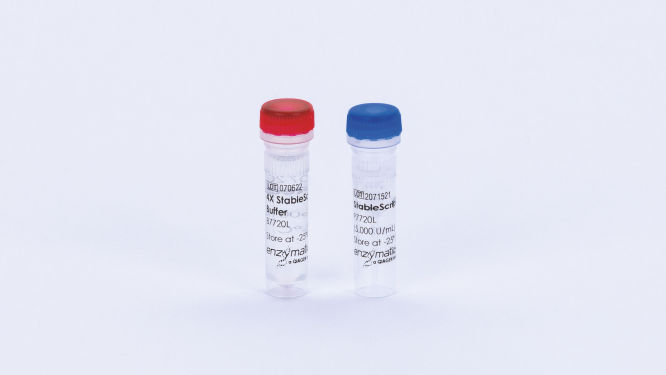Cat. No. / ID: P7720L
Features
- Versatile reverse transcriptase suitable for RT-PCR and one-step-RT-qPCR
- Recommended for long-range RT-PCR
- Highly sensitive RNA detection
- Improved thermostability, processivity and inhibitor resistance
Product Details
StableScript is a versatile reverse transcriptase designed for use in one-step RT-qPCR and long-range RT-PCR. StableScript reverse transcriptase has no detectable RNase H activity and demonstrates increased thermostability, performing well at a temperature range of 45° to 65°C. This helps to overcome the detection challenges of difficult RNA targets and enables high cDNA yields. StableScript reverse transcriptase shows reliable performance in the presence of common inhibitors.
One unit of StableScript Reverse Transcriptase is defined as the amount of enzyme required to incorporate 1 nmol of dTTP into acid insoluble material in 30 minutes at 55°C using poly r(A)/oligo(dT) as a substrate.
The enzyme is supplied in 20 mM KPO4, 1 mM EDTA, 1 mM DTT, stabilizer, 50% glycerol; pH 7.0 at 25°C.
The enzyme is supplied with a 4X StableScript Reaction Buffer.
Performance
Polymerase properties
- Optimum extension temperature: 55°C
- Transcript length: Up to 12.3 kb
| Test | Specification |
| Purity | >99% |
| Single-stranded exonuclease | 5000 U <5% released |
| Double-stranded exonuclease | 5000 U <1% released |
| Double-stranded endonuclease | 5000 U = No conversion |
| E. coli DNA contamination | 5000 U <10 copies |
| RNase contamination | 5000 U; No detectable non-specific RNase |
| Functional RT-PCR assay | Amplification of test lot within 1 Ct of reference lot in a one-step RT- qPCR assay |
Principle
Reverse transcriptase (RT), also known as RNA-dependent DNA polymerase, is a DNA polymerase enzyme that transcribes single-stranded RNA into DNA. Reverse transcriptases are used by viruses such as HIV and hepatitis B to replicate their genomes, by retrotransposons to proliferate within a host genome.
Reverse transcriptases are used in molecular biology to detect and manipulate RNA molecules through amplification. Reverse transcriptases polymerize a strand of DNA (cDNA) that is complimentary to an original RNA template. The cDNA can then be further amplified through PCR, and qPCR for downstream analysis of transcripts and gene expression.
RNase H activity degrades the RNA strand of a DNA/RNA hybrid and frees the newly made DNA strand for use as a template in the synthesis of the second strand of DNA. RNase H activity is considered disadvantageous for synthesis of long cDNAs due to the potential of the enzyme to degrade the RNA template before completion of full-length reverse transcription.
StableScript Reverse Transcriptase has no detectable RNase H activity and has increased thermostability. The enzyme demonstrates high sensitivity for RNA detection, increased processivity and enhanced resistance to inhibitors.
Procedure
Instructions for using StableScript Reverse Transcriptase are provided in the corresponding kit protocol in the resources below.
Quality Control
Unit activity of StableScript Reverse Transcriptase was measured using a two-fold serial dilution method. Dilutions of enzyme were made in 1X StableScript Diluent and added to 50μL reactions containing 20μg/mL poly r(A) RNA, oligo (dT) DNA, 1X StableScript Reaction Buffer, 3H-dTTP and 250 μM dTTP and analyzed using the method of Sambrook and Russell (Molecular Cloning, v3, 2001, pp. A8.25-A8.26).
Protein concentration of StableScript Reverse Transcriptase (OD280) was determined by OD280 absorbance.
StableScript Reverse Transcriptase physical purity was evaluated by SDS-PAGE of concentrated and diluted enzyme solutions followed by silver stain detection. Purity was assessed by comparing the aggregate mass of contaminant bands in the concentrated sample to the mass of the protein of interest band in the diluted sample.
Single-stranded exonuclease activity in StableScript Reverse Transcriptase was determined in a 50 μL reaction containing a radiolabeled single-stranded DNA substrate and 10 μL of enzyme solution incubated for 4 hours at 37°C.
Double-stranded exonuclease activity in StableScript Reverse Transcriptase was determined in a 50 μL reaction containing a radiolabeled double-stranded DNA substrate and 10 μL of enzyme solution incubated for 4 hours at 37°C.
Double-stranded endonuclease activity in StableScript Reverse Transcriptase enzyme was determined in a 50 μL reaction containing 0.5 μg of plasmid DNA and 10 μL of enzyme solution incubated for 4 hours at 37°C.
E. coli contamination of StableScript Reverse Transcriptase was evaluated using 5 μL replicate samples of enzyme solution denatured and screened in a TaqMan qPCR assay for the presence of contaminating E. coli genomic DNA using oligonucleotide primers corresponding to the 16S rRNA locus.
Non-specific RNase contamination of StableScript Reverse Transcriptase was assessed using a nuclease detection kit following the manufacturer’s guidelines.
The functionality of the RT-PCR assay was evaluated by amplification of three mRNA transcripts in a one-step RT-qPCR assay. The amplification threshold (Ct) of the test lot was compared to a reference lot.
Applications
This product is available for molecular biology applications such as:
- RT-qPCR
- cDNA synthesis
- Long-range RT-PCR
- Next-generation sequencing

